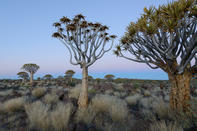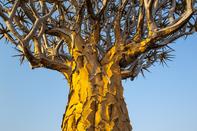Beautiful Bark
Aloe dichotoma, the distinctive quiver tree or tree aloe, is a giant in a sea of Lilliputian scrub. It towers over its surrounds, reaching a handsome two to three metres at full height. As a seedling, it starts life looking not unlike most young aloes - a rosette of spear-like leaves emerging from the ground.

Over the years, as this crown grows taller, a stem of sheer, solid wood develops. The young bark is a beautiful, silky silver-beige wrapping over a fibrous core. Eventually, the tall, slim tree splits, sending out a second branch, then a third, then a fourth, until it grows into a neatly topiaried ball of aloe-leaved growth over a constantly widening stem.
By old age - which could be as much as two hundred years or more - the tree takes on a curious hour-glass shape with its ample trunk, slim midriff and neat canopy.
Years of Uses

San people, who have migrated through these parts for thousands of years, used the tree's branches as quivers for arrows. Settlers used hollowed-out dead trees as makeshift fridges to store 'water, meat and vegetables'; the 'fibrous tissue of the trunk has a cooling effect as air passes through'.
Quiver trees thrive in the dry Nama and succulent karoos. Their range stretches from the Namaqualand near Nieuwoudtville and Loeriesfontein in the south to Brandberg in the Nama Desert; from Prieska in the east to Swakopmund in the west. Tough and resilient, quiver trees store water reserves in their stems and leaves and can endure years of drought conditions.
By Leonie Joubert